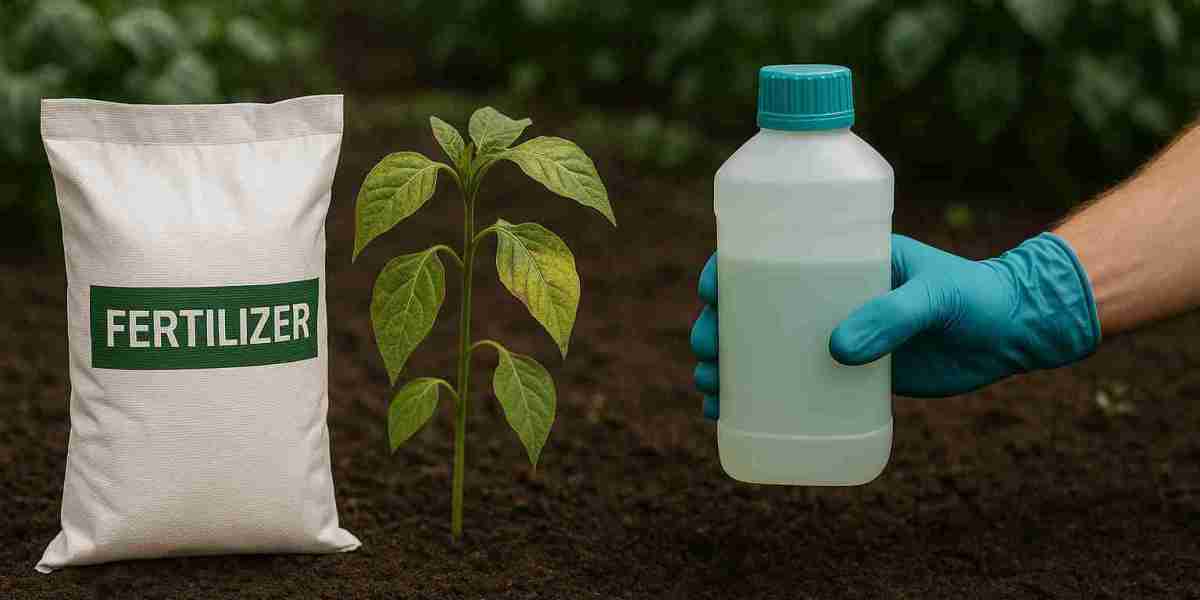Fertilizers are the cornerstone of modern agriculture, yet not all fertilizers are created equal. Among the vast array of nutrient solutions available, two often spark debate: chelated and non-chelated fertilizers. Both are designed to provide essential micronutrients to crops, but the way they deliver these nutrients, their efficiency, and their long-term impact on soil and yield can vary significantly.
Knowing the difference between chelated and non-chelated fertilisers is more than just a technical detail if you're a grower trying to maximise farm productivity while maintaining sustainability; it's a crucial decision that affects everything from crop health to cost-efficiency.
What Are Chelated Fertilizers?
The micronutrients included in chelated fertilisers, such as iron, zinc, manganese, or copper, are bonded to an organic compound called a chelating agent. Particularly in alkaline soils, where nutrients typically become unavailable to plants, this bonding stops the micronutrients from reacting with other substances in the soil.
Chelation preserves nutrients in a state that is soluble and readily absorbed by plants through their roots or leaves. EDTA, DTPA, and EDDHA are common chelating agents; their stability varies according to the soil's pH.
- They increase nutrient bioavailability in challenging soil conditions.
- They reduce the need for repeated applications, saving time and resources.
This molecular shielding is what makes chelated fertilizers particularly effective in soils with high pH or heavy clay content—where non-chelated micronutrients might otherwise be locked up and rendered useless.
Non-Chelated Fertilizers: The Conventional Alternative
In contrast, non-chelated fertilisers supply micronutrients in their unprocessed, unprotected state. Although they are frequently more accessible and less expensive, the quality of the soil significantly affects their effectiveness. In soils that are neutral or slightly acidic, these fertilisers can function perfectly. They often combine with other minerals to form insoluble compounds in calcareous or alkaline soils, though.
This chemical reaction effectively “hides” the nutrient from the plant, resulting in deficiencies even when the soil technically contains adequate levels.
These types of fertilizers are typically used when:
- The soil pH is already optimal for nutrient uptake.
- The focus is on short-term correction of deficiencies rather than long-term nutrient management.
Why Chelation Matters More Than You Think
A key component of a nutrition management plan, chelation is more than just a catchphrase. When it comes to micronutrient delivery, the differences are very noticeable. For instance, soils with a pH higher than 7.5 make iron very inaccessible unless it is chelated.
Chelation is an essential technique for making sure crops truly receive what you apply in areas with problematic soil alkalinity or water quality.
Farmers may be left scratching their heads over stunted growth or chlorosis if they use non-chelated inputs on crops with high micronutrient demands or sensitivity, including citrus, grapes, or some vegetables.
In this context, many modern growers choose to Purchase Chelated Micronutrient Fertilizer as part of a broader nutrient strategy designed to align with precision agriculture goals. This enables better nutrient targeting, reduced environmental leaching, and more consistent crop responses.
Cost Comparison: A Misleading Metric
Chelated fertilisers are much more costly on the surface. However, this initial expense is not the complete picture. Although non-chelated fertilisers may appear cost-effective, their low nitrogen uptake frequently necessitates bigger volumes or more frequent applications. The hidden costs of crop loss, inefficiency, and soil damage may eventually outweigh the initial savings.
An average of 12% more crops were produced and 17% less nutrient waste per acre was generated by farms that incorporated chelated fertilizers into their micronutrient regime, according to a 2023 market analysis by CropNutrientStats.org.
Therefore, cost-per-yield-acre provides a different narrative that is more pertinent to a farmer's bottom line, even though cost-per-pound may favour non-chelated choices.
Soil Chemistry: The Invisible Game-Changer
The actual difference between chelated and non-chelated fertilisers lies in the chemistry of the soil. High pH values (over 7.0) have a significant impact on the availability of nutrients. Fixation is a phenomena in which iron, manganese, and zinc combine to form insoluble compounds that are insoluble to roots.
Chelated nutrients get beyond this restriction because of their ligands, which are the organic claws that hold onto the nutrient ions. They make it possible for nutrients to remain soluble and mobile, allowing them to reach plant roots unhindered.
On the other hand, non-chelated minerals frequently experience "nutrient lockout," particularly in areas with high amounts of lime or bicarbonate. In irrigated fields, where frequent watering gradually changes pH and salinity levels, this is especially troublesome.
A Farmer’s Dilemma: Balancing Immediate Needs with Long-Term Gains
The decision between chelated and non-chelated fertilisers for many small and mid-sized producers comes down to cost against long-term results. However, more people are reevaluating this trade-off as farming moves away from bulk inputs and towards focused efficiency.
According to Dr. Eric Langston, a soil scientist with AgGrow Research, "farming is about correcting problems before they develop, not after." "Farmers benefit from chelation, particularly in regions where soil conditions are constantly changing."
Selecting the best fertiliser involves more than simply what is currently effective; it also entails creating a reliable nutrient delivery system that will support your farm's long-term goals.
When Chelated Fertilizers Make the Most Sense
There are specific situations where chelated fertilizers are not just preferable, but essential:
- High pH soils (>7.5), especially in arid and semi-arid regions.
- Crops with high micronutrient sensitivity, such as beans, citrus, and ornamental plants.
- Soilless media, such as hydroponics, where nutrient availability is controlled entirely by the solution.
- Foliar feeding programs that demand quick and direct nutrient absorption.
In these environments, chelated fertilizers significantly outperform their non-chelated counterparts, providing both faster results and improved long-term consistency.
The Flip Side: Where Non-Chelated Fertilizers Still Win
Despite their limitations, non-chelated fertilizers still hold value in certain contexts:
- Organic farming systems that restrict the use of synthetic chelating agents.
- Low pH soils where chelation may be unnecessary or excessive.
- Budget-constrained operations focused on rapid short-term nutrient correction.
Farmers working with precision nutrient mapping and regular soil testing can effectively integrate non-chelated fertilizers, provided they closely manage soil conditions and apply nutrients during peak uptake windows.
Are All Chelates Created Equal?
Not quite. The effectiveness of a chelated fertilizer depends heavily on the type of chelating agent used. For example:
- EDTA: Effective up to pH 6.5–7.0.
- DTPA: Works well up to pH 7.5.
- EDDHA: Remains stable and bioavailable even in soils with pH as high as 9.0.
If you're applying iron to alkaline soils and using EDTA, you may still encounter problems. Understanding the stability range of the chelate used is just as important as the decision to chelate in the first place.
What the Science Says
EDDHA-chelated iron preserved 88% bioavailability in soils above pH 8.5, while non-chelated iron only maintained 24%, according to peer-reviewed research published in the Journal of Soil and Plant Nutrition. Field data from agricultural cooperatives in Southern Spain and California have confirmed these conclusions.
Through technologies like AgriFutures' SoilMate, which helps customise fertiliser regimens based on local conditions, farmers can obtain region-specific soil pH and fertiliser compatibility information.
According to the report, "understanding soil chemistry is no longer optional—it's part of being a successful farmer." That is the degree of accuracy that distinguishes record-breaking harvests from typical yields.
FAQs
- Do chelated fertilizers harm soil biology?
No, most chelating agents (when used within recommended rates) do not negatively impact soil microbial life. In fact, better nutrient availability can improve root exudates that support beneficial microbes. - Can I mix chelated and non-chelated fertilizers?
Yes, but it’s important to monitor interactions, as some mixtures may lead to precipitation or pH shifts. Always conduct a jar test before combining different products. - Are chelated fertilizers safe for organic farming?
Most synthetic chelates like EDTA and DTPA are not approved for certified organic systems. However, natural chelating agents like lignosulfonates or amino acids may be acceptable. - Why is my crop still deficient despite applying micronutrients?
Likely due to soil pH or nutrient lockout. Switching to chelated forms, especially for iron, zinc, and manganese, can often solve persistent deficiency issues. - How often should I apply chelated fertilizers?
This depends on crop type and delivery method. Foliar applications may need repetition every 2–4 weeks, while soil-applied chelates can remain effective longer, depending on rainfall and irrigation.
Keep Asking the Right Questions
Consider this rather than a conclusion: each farm is a live system with its own set of variables and problems. What is effective for one crop, soil type, or climate may not be effective for another. Therefore, the goal of the chelated vs. non-chelated fertiliser argument is to ask more intelligent questions rather than to determine a clear winner.
Is what you're applying being absorbed by your crops? By pursuing short-term savings, are you ultimately paying more? Do you always strive to outsmart your soil, or are you working with it?
Continue testing, maintain your curiosity, and advance with the science. Your produce and soil will appreciate it.




